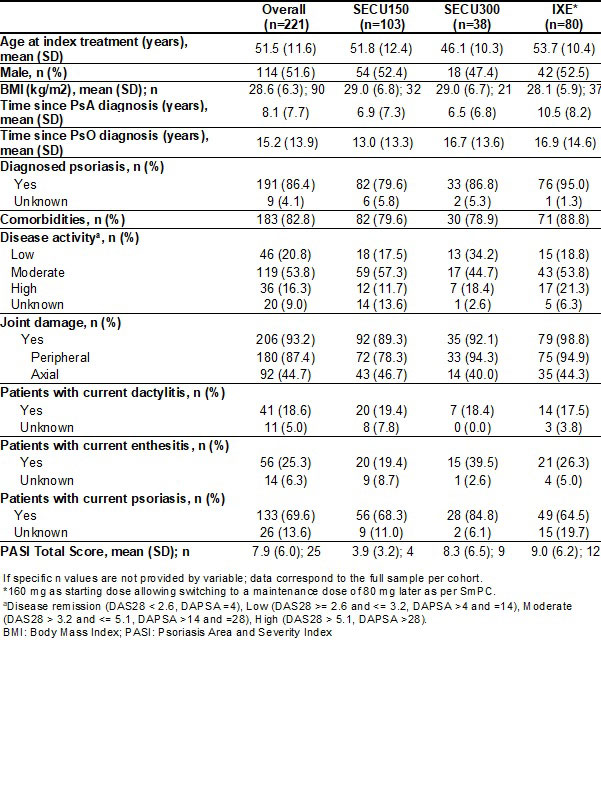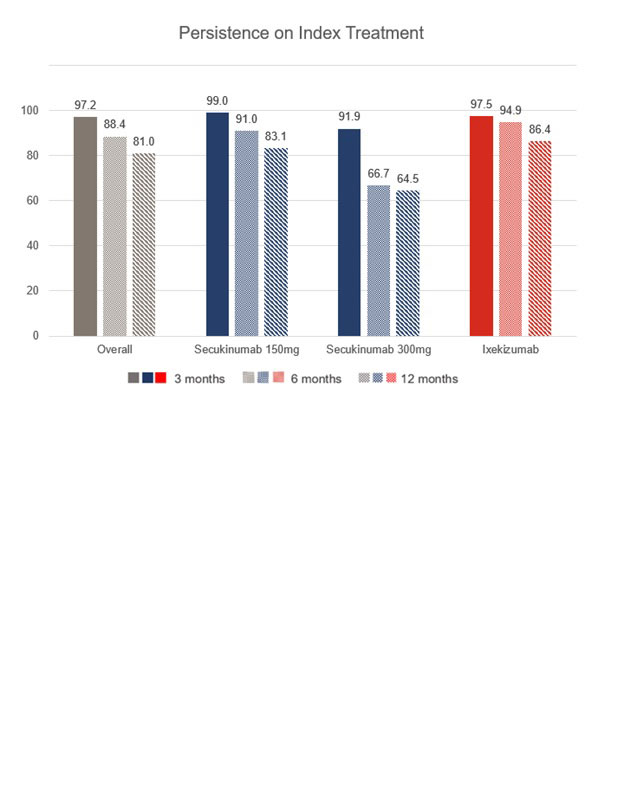Session Information
Session Type: Poster Session D
Session Time: 1:00PM-3:00PM
Background/Purpose: Interleukin-17A inhibitors (anti-IL17) have provided an additional treatment option in the management of the psoriatic arthritis (PsA). This study aims to describe the patient profile, treatment patterns and persistence in PsA patients treated with ixekizumab and secukinumab in a real-life setting.
Methods: A multicenter retrospective study was conducted at 8 Spanish hospitals. Three cohorts of adult PsA patients, newly initiating treatment with an anti-IL17 (secukinumab 150mg [SECU150], secukinumab 300mg [SECU300] or ixekizumab [IXE]), between January-2019 and March-2020 were included. Data of patients exposed to anti-IL17 drugs and with a follow-up visit available were collected until March-2021. Demographic and clinical characteristics, treatment patterns, and persistence were analyzed descriptively. Continuous data were presented as mean (Standard Deviation (SD)) and categorical variables as frequencies with percentage. Persistence rates at 3/6/12 months were calculated.
Results: A total of 221 PsA patients were analysed (SECU150: 103 [46.6%], SECU300: 38 [17.2%] and IXE: 80 [36.2%]). Patients in the SECU150 group presented higher proportion of moderate PsA and less peripheral joint counts. The highest proportion of patients with enthesitis and active skin lessions due to psoriasis in the moment of the prescription was in the SECU300 group. Patients in the IXE group showed longer time since PsA diagnosis, had more frequent comorbidities, joint damage and psoriasis diagnosed (Table 1). 77.8% of patients were previously treated with csDMARDs in monotherapy and 72.9% with bDMARDs/tsDMARDs. The lowest proportion of patients with a prior bDMARDS/tsDMARDS use was observed in the SECU150 group (58.3%), followed by SECU300 (68.4%) and the highest in the IXE group (93.8%). Mean number of previous bDMARDS/tsDMARDS for SECU150, SECU300 and IXE groups were 1.6(1.0), 1.7 (0.9) and 2.4 (1.5), respectively. Anti-IL17 persistence is shown in Figure 1. Most frequent reason for discontinuation was lack of effectiveness (13.8%).
Conclusion: Most of PsA patients treated with anti-IL17 in Spain had a moderate or high disease activity, high peripheral joint damage and skin involvement and had received at least 1 previous bDMARDS/tsDMARDS. More than 80% of patients with one year follow-up were persistent to anti-IL17 treatments, observing the highest rate with IXE, followed by SECU150 and SECU300.
To cite this abstract in AMA style:
JOVEN B, Fito Manteca C, Rubio E, Raya Álvarez E, Pérez A, Hernández R, Manrique Arija S, Núñez M, Díaz S, Trancho L, Moyano S, Lacetera A, Alfaro-Oliver N, Garcia-Vicuña R. Real-world Persistence and Treatment Patterns in Psoriatic Arthritis Patients Treated with Anti-IL17 Therapy [abstract]. Arthritis Rheumatol. 2022; 74 (suppl 9). https://acrabstracts.org/abstract/real-world-persistence-and-treatment-patterns-in-psoriatic-arthritis-patients-treated-with-anti-il17-therapy/. Accessed .« Back to ACR Convergence 2022
ACR Meeting Abstracts - https://acrabstracts.org/abstract/real-world-persistence-and-treatment-patterns-in-psoriatic-arthritis-patients-treated-with-anti-il17-therapy/


